Trees Birds Mammals Fish Amphibians Reptiles
Wild Algarve
Bookshop
Clitocybe nebularis (Batsch) P. Kumm. - Clouded Funnel
Phylum: Basidiomycota - Class: Agaricomycetes - Order: Agaricales - Family: Tricholomataceae
Distribution - Taxonomic History - Etymology - Toxicity - Identification - Reference Sources

Clitocybe nebularis, commonly called the Clouded
Funnel (and formerly more often referred to as the Clouded Agaric), is often found growing in rings in coniferous forests. Although quite variable in appearance, there is something about this chunky mushroom that makes it recognisable from quite some distance. This
mushroom also grows in deciduous woods and beneath hedgerows.
Occasionally large fairy rings or masses of Clouded Funnels can even appear in shrubberies!
The fairy ring of Clouded Funnels shown (only in part) below was in spruce woodland in Wales; the ring was nearly eight metres in diameter and comprised more that 50 fruitbodies..
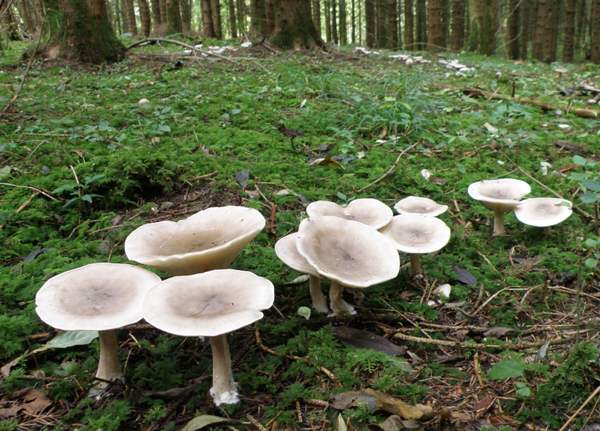
Distribution
Very common throughout Britain and Ireland, the Clouded Funnel also occurs in most parts of mainland Europe from Scandinavia to the southernmost parts of the Iberian Peninsula and the shores of the Mediterranean. This species is also found in many parts of North America.
Taxonomic history
The Clouded Funnel was first described in 1789 by August Johann Georg Karl Batsch, who named it Agaricus nebularis. (In the early days of fungal taxonomy most gilled fungi were initially placed in a giant Agaricus genus, now largely redistributed across many other genera.) In 1871 this species was transferred to the genus Clitocybe by the famous German mycologist Paul Kummer, who renamed it Clitocybe nebularis. After a couple of genus 'false moves' it is now firmly resited where Kummer had located it, and indeed Clitocybe nebularis is the type species of the genus Clitocybe, so that were it to be moved to another genus all species that did not move with it would have to be renamed in accordance with the strict rules of International Code of Botanical Nomenclature (ICBN).
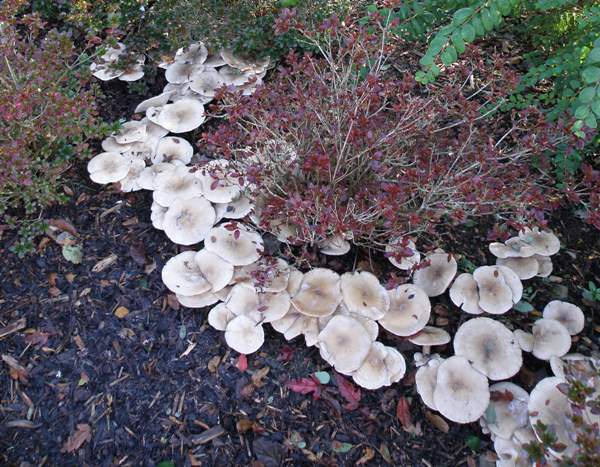
Synonyms of Clitocybe nebularis include Agaricus nebularis Batsch, Gymnopus nebularis (Batsch) Gray, Omphalia nebularis (Batsch) Quel., and Lepista nebularis (Batsch : Fr.) Harmaja.
Etymology
The generic name Clitocybe means
'sloping head', while the specific epithet comes from the Latin noun nebula, meaning mist - the stuff of clouds. The common name Clouded Funnel refers to the cloud-like colouring of the cap and its shallow funnel-like shape when fully mature.
Toxicity
Once considered edible, this chunky and plentiful mushroom is now generally treated as suspect. While not the most toxic of toadstools it can seriously upset some people who eat it and so is
probably best avoided when gathering fungi for the pot.
Above: Clitocybe nebularis in a shrubbery at the National Botanic Garden of Wales. Seeing this spectacularly dense display I wondered whether Crowded Funnel would be a more appropriate common name for this species!
Only very occasionally, usually once they are fully mature or beginning to decay, Clouded Funnels may be parasitised by a rare pink-gilled mushroom Volvariella surrecta. These amazing fungi have been given the English name Piggyback Rosegill, and if you find any Clouded Funnels it's always worth looking closely at every cap just in case this white parasite is hitching a ride.
Identification guide
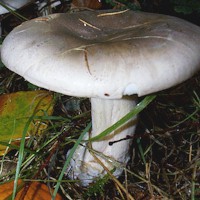 |
This large mushroom is also commonly
referred to as the Clouded Agaric or the Clouded Funnel Cap. It is common to see large rings of Clitocybe nebularis in
coniferous woods - a trait this species shares with its close relative the Wood Blewit Lepista
nuda. |
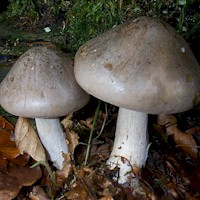
|
Cap
Convex or conical at first, the caps of this
large mushroom take up to a month to expand fully. Eventually they flatten
out and often become slightly funnel-shaped with a wavy margin which usually remains downturned or even slightly inrolled.
When fully expanded, caps of the Clouded Funnel range from 6 to 20cm in diameter and
are grey, often with a cloud-like pattern in the central region. The
surface is often covered with a pale felt-like bloom. |

|
Gills
White becoming pale cream with age, the
crowded gills of Clitocybe nebularis are adnate or slightly decurrent to the stem. |
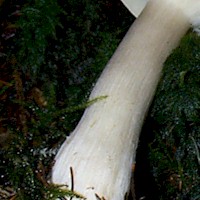
|
Stem
2 to 3cm in diameter and with a swollen base, the solid stem of the Clouded Funnel is 6 to 12cm
tall, smooth and slightly paler than the cap. |
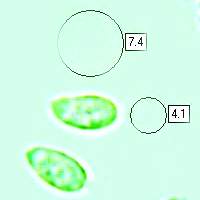 |
Spores
Ellipsoidal, smooth, 6.5-8.5 x 3.5-4.5μm.
Spore print
Creamy white to very pale buff. |
Odour/taste |
Sweet fruity smell (although some people
detect an odour of turnip); no distinctive taste. |
Habitat & Ecological role |
Saprobic, in broad-leaf and coniferous woodland and
beneath hedgerows. |
Season |
August to early December in Britain and Ireland. |
Similar species |
Lepista nuda, the Wood Blewit, is similar in form but has pale lilac
sinuate gills.
Entoloma sinuatum has yellowish gills at maturity and its spores are pink rathet than white; it is a poisonous mushroom and so great care is essential when collecting any pale-capped, whitish-gilled fungi for eating. |
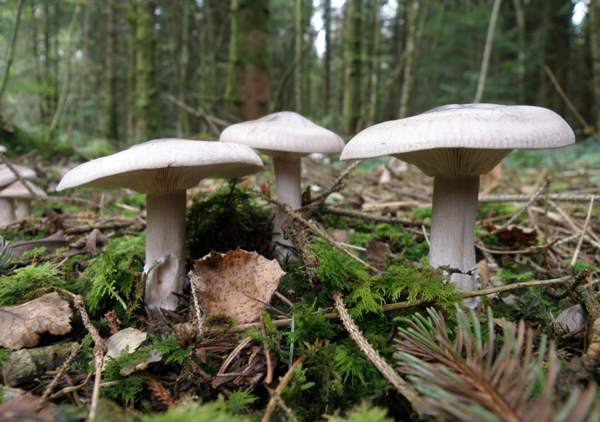
Reference Sources
Fascinated by Fungi, 2nd Edition, Pat O'Reilly 2016, reprinted by Coch-y-bonddu Books in 2022.
British Mycological Society (2010). English Names for Fungi
Funga Nordica, Henning Knudsen and Jan Vesterholt, 2008.
Dictionary of the Fungi; Paul M. Kirk, Paul F. Cannon, David W. Minter and J. A. Stalpers; CABI, 2008
Taxonomic history and synonym information on these pages is drawn from many sources but in particular from the British Mycological Society's GB Checklist of Fungi.
Top of page...
Fascinated by Fungi. Back by popular demand, Pat O'Reilly's best-selling 450-page hardback book is available now. The latest second edition was republished with a sparkling new cover design in September 2022 by Coch-y-Bonddu Books. Full details and copies are available from the publisher's online bookshop...